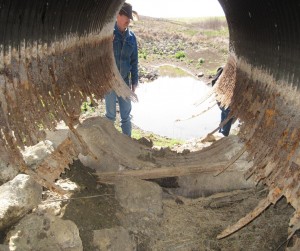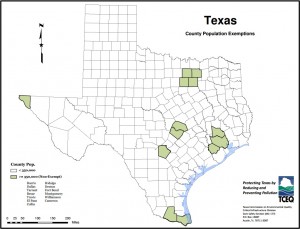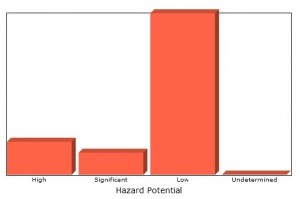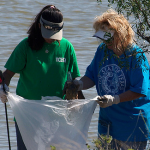How Hundreds of ‘Significant Hazard’ Dams Escape State Inspection in Texas

Photo from TCEQ
A photo of a rusted out pipe taken during a TCEQ inspection of a dam. This picture is now used in dam safety workshops presented by TCEQ.
This is part two of a series devoted to looking at the infrastructure of dams in Texas, and what can be done to improve it. You can find part one here and part three here.
In 2008, the Texas State Auditor’s office released the kind of report that keeps public officials awake at night. It found that state regulators were not ensuring the proper maintenance of thousands of dams in Texas. The audit found that state inspectors had never visited hundreds of dams that could cause loss of life if they failed.
The Dam Safety Program with the Texas Commission on Environmental Quality is in charge of inspecting the state’s dams. Warren Samuelson, the program’s manager, says that his department has added staff and made progress since that audit was issued.
“At the end of 2011 we had all of them… except a handful that we couldn’t get into. We were able to look at all of these high and significant hazard dams,” Samuelson told StateImpact Texas.
A significant hazard dam is a one that could possibly kill people and most certainly cause economic loss if it were to fail. If a high hazard dam fails, it will probably kill people and cause major property damage. About 60 percent of dams in Texas are on private land, making the job of inspecting them more difficult. But, Samuelson says, now that all high and significant hazard structures have been inspected, they will not fall from view of his program.
“Now we’re going back out, touching base with the owners, and see if they corrected some of the things we asked them to do,” he said.
But there are hundreds of dams that regulators will not be allowed to check up on.
The reason is a law state legislators passed earlier this year. Under House Bill 677, nearly 3,000 dams in the state were exempted from inspection. Two hundred and sixteen of those were significant hazard dams, according to a dam safety presentation given by the TCEQ. That means that about 30 percent of the state’s inventory of significant hazard dams, the same dams the auditor’s office urged officials to monitor, will now forgo inspection by the state.

TCEQ
A map from the TCEQ shows all the counties (in white) where dams qualify for the exemptions. The counties in green are too populated to qualify.
The bill was a re-iteration of legislation passed in 2011. That bill granted exemptions, but not permanently. The new law, which applies to private dams in rural parts of the state, has no sunset provision. It was presented as a way to lessen the burden of regulation on private dam owners.
Ralph Duggins is one such owner who was in favor of the bill. His earthen dam in Johnson County had recently been rated a significant hazard because of a house that was built downstream. He was required to upgrade the dam under state law, a measure which he called unnecessary and expensive.
Duggins spoke at a hearing of the bill earlier this year, where he complained that the TCEQ was “going all over the state using aerial photos and demanding that private dam owners re-engineer spillways and add freeboard.”
The TCEQ says dam owners are still responsible for the maintenance and upkeep of their dams, the new law stops inspectors from checking up on them, and relieves them of state safety requirements.
A ‘Rather Broad Brush’
Before the law passed, some engineers urged funding to ensure that dangerous infrastructure would not escape inspections. Wes Birdwell was among them. He is a civil engineer who is worried about the consequences of exempting so many structures, especially those that pose significant hazards.

Photo by Mose Buchele
Civil Engineer Wes Birdwell urged the state to invest more in research on dams.
“The rather broad brush approach that was taken is somewhat concerning,” Birdwell said of the law.
At his Austin office Birdwell gave a quick lesson in how to determine the hazard classification of a dam. He pulled up a Google satellite view of a dam he knew to be in good condition. Near it was near maze of development, with homes and suburban cul-de-sacs looking almost like circuitry installed below the dam.
He said that image, overlaid with a floodplain map, could give a good idea of how many houses could be in danger. It would take some state money and partnership with federal agencies, but officials could eventually use fairly simple tools to track the potential impacts of Texas dams, according to Birdwell.
“In a couple years we could look back through all the dams that are regulated by the state. We could see where development is occurring. We can see where the dams might need to become regulated in the next few years and we could plan accordingly,” he said.

Graphic from USACE National Dam Inventory
A graphic from the Army Corp of Engineers showing the hazard classifications of dams in Texas. According to the Corps there are 743 significant hazard dams in the state and over 1100 high hazard dams.
Lawmakers opted against that approach, instead granting blanket exemptions from inspection. The passage of the bill was a victory for some rural dam owners. But, perhaps not for public safety.
Bill Smith is emergency program manager for Jasper, Newton, and Sabine Counties, in East Texas. He’s also the flood plain administrator for Jasper County. He says he’d like to know more about private rural dams in his area, not less.
“Smaller dams do cause a concern. Especially for the ones that are in proximity of them,” Smith told StateImpact Texas.
But even dams that are inspected can be hard to learn about. Tomorrow, StateImpact Texas will report on how homeland security rules are blocking access to information we do have about dams in Texas.
Correction: An earlier version of this story said that dam owners still need to follow requirements for maintaining their dams under HB 677. In fact, the law frees dam owners from meeting TCEQ requirements. The TCEQ says they are simply still “responsible” for the maintenance and upkeep of their dams.
